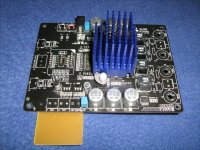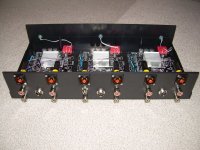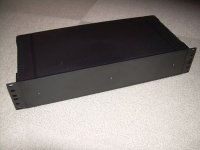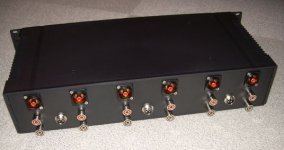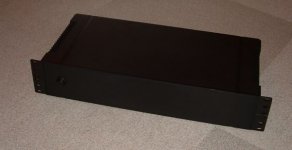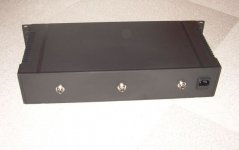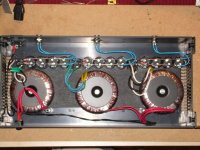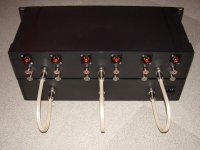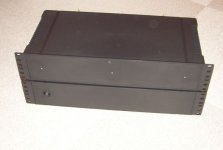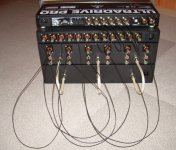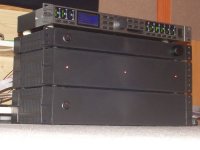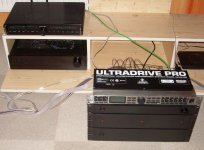I was measuring the output DC without any source connected.You shouldn't remove the input cap on tripath amplifiers. This is because the input is biased at 2.5v. Without the input casp, the 2.5V DC will be amplified and appear as high DC on the output.
I plan to use the offboard input caps later, when I settle this problem.
Or, maybe, some input caps should be always connected?
Will check that.
Thank you col_s
DC
So the DC is adjustable to 0mv as normal with the gain switches off? Does it play? Can you post some photos?Unfortunately, hi DC appeared on output. Depending of the input gain it's 22V and 24V, both channels. With the gain off there is no output dc.
So the DC is adjustable to 0mv as normal with the gain switches off? Does it play? Can you post some photos?
Thanks Scott, will report tomorrow.
Baki
I was measuring the output DC without any source connected.
I plan to use the offboard input caps later, when I settle this problem.
Or, maybe, some input caps should be always connected?
Yes input caps should always be connected between the source and the input, and you should always test for DC with the source connected. There is 2.5V DC difference in potential between ground and the input, most of which will flow back through the source if it is connected without the DC blocking input cap. This DC voltage then gets amplified.
Hi Scott,
This is the picture of the modifications I have done so far.
Output filter caps are placed underneath.
I have measured the dc offset as follows:
gain setting off: L 29mV, R 57mV
gain setting medium: L 21V, R 22V
gain setting high: L 24V, R 24V.
Baki
This is the picture of the modifications I have done so far.
Output filter caps are placed underneath.
I have measured the dc offset as follows:
gain setting off: L 29mV, R 57mV
gain setting medium: L 21V, R 22V
gain setting high: L 24V, R 24V.
Baki
Attachments
Yes input caps should always be connected between the source and the input, and you should always test for DC with the source connected. There is 2.5V DC difference in potential between ground and the input, most of which will flow back through the source if it is connected without the DC blocking input cap. This DC voltage then gets amplified.
Will do that today.
Thanks, Baki
R23, R?
You just need to remove R23/ R? pair (I don't have the new version schematic) whenever you jump the input cap. They are the resistors next to the removed input caps. They look like they are after the cap in the input flow but they are actually isolated from the amp by the caps. They serve as input termination to ground and are the first thing the input encounters, along with the removed over level protection zeners. With the caps jumped, the 2.5v bias of the input section is now shorted through the resistors. They serve mainly to keep the amp quiet whenever it is on with no input connected. You can add them back in, in front of your new caps as a resistor or a pot or install your new caps in the stock pads or run without them but most sources sound best with a true 20-100K load to work into.
Hi Scott,
This is the picture of the modifications I have done.
You just need to remove R23/ R? pair (I don't have the new version schematic) whenever you jump the input cap. They are the resistors next to the removed input caps. They look like they are after the cap in the input flow but they are actually isolated from the amp by the caps. They serve as input termination to ground and are the first thing the input encounters, along with the removed over level protection zeners. With the caps jumped, the 2.5v bias of the input section is now shorted through the resistors. They serve mainly to keep the amp quiet whenever it is on with no input connected. You can add them back in, in front of your new caps as a resistor or a pot or install your new caps in the stock pads or run without them but most sources sound best with a true 20-100K load to work into.
You shouldn't remove the input cap on tripath amplifiers. This is because the input is biased at 2.5v. Without the input casp, the 2.5V DC will be amplified and appear as high DC on the output.
He could even remove the input caps and install the externally
but he has to remove the 2 resistors that goes to ground. Everything is well explained in the first 10 pages of this threat. Audio1st explained his problem to someone.
High quality output caps.
I've already did
-input caps
-output coils
-passive cooling
This amp is so good that I want to make further changes. Time for output caps. Any suggestions ? What types, brands, values ? Thanks in advance.
PS. Is there anything left to do ? Maybe power caps ? Sugestions ?
I've already did
-input caps
-output coils
-passive cooling
This amp is so good that I want to make further changes. Time for output caps. Any suggestions ? What types, brands, values ? Thanks in advance.
PS. Is there anything left to do ? Maybe power caps ? Sugestions ?
What types, brands, values ?
I am using WIMA MKP10 2x0,22uF/250V, stacked one above the other, beneath the board. So, 0,44uF in total.
Here some pictures about my 6 channels SURE TK2050 D amp.
The amp and the psu are in separate box.
The fan was removed, the biger heatsinks are coming. The imput caps and resistors and supressors, and the diode in the psu line was removed. The input caps are 2,2uF Bennic XPP.
Pictures about inside of the amp:
The amp and the psu are in separate box.
The fan was removed, the biger heatsinks are coming. The imput caps and resistors and supressors, and the diode in the psu line was removed. The input caps are 2,2uF Bennic XPP.
Pictures about inside of the amp:
Attachments
Last edited:
In my system:
- Slim Devices Transporter
- Modded Behringer DCX2496 active DSP loudspeaker manager
- 6 channel analogue volume controller with 6ch ALPS motorized and remoted pot
- Six ch Sure D amp
- Tha amp PSU
- Slim Devices Transporter
- Modded Behringer DCX2496 active DSP loudspeaker manager
- 6 channel analogue volume controller with 6ch ALPS motorized and remoted pot
- Six ch Sure D amp
- Tha amp PSU
Attachments
Fabulous build, kalmi!! I love it. 😀
What are you using for source cables?
Thank you!
My interconnect, psu and speaker cables from a swedish manufacturer. Name is HABIA!
Not specially in audio applications, but these cables give the cleanest sound what I ever heard!
Every HABIA cable what I use, is a silver plated model!
- Status
- Not open for further replies.
- Home
- Amplifiers
- Class D
- Sure Electronics New Tripath Board tc2000+tp2050
